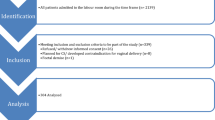Abstract
Purpose
To ascertain any differences in foetomaternal outcomes in induced and spontaneous labour among nulliparous women delivering at term.
Methods
A retrospective matched cohort study consisting of 403 nulliparous women induced at ≥292 days and 806 nulliparous women with spontaneous labour at 285–291 days.
Results
Compared to those in spontaneous labour, women who had induction of labour were three times more likely to have a caesarean delivery (OR 3.1, 95% CI 2.4–4.1; P < 0.001). Women who had induction of labour were 2.2 times more likely to have oxytocin augmentation (OR 2.2, 95% CI 1.7–2.8; P < 0.001), 3.6 times more likely to have epidural anaesthesia (OR 3.6, 95% CI 2.8–4.6; P < 0.001), 1.7 times more likely to have uterine hyperstimulation (OR 1.7, 95% CI 1.1–2.6), 2 times more likely to have a suspicious foetal heart rate trace (OR 2.0, 95% CI 1.5–2.6), 4.1 times more likely to have blood loss over 500 ml (OR 4.1, 95% CI 2.9–5.5; P < 0.001), and 2.9 times more likely to stay in hospital beyond 5 days (OR 2.9, 95% CI 1.5–5.6; P < 0.001). Babies born to mothers who had induction of labour were significantly more likely to have an Apgar score of <5 at 5 min and an arterial cord pH of <7.0.
Conclusion
Compared to those with spontaneous labour, nulliparous women with induced labours are more likely to have uterine hyperstimulation, caesarean delivery, and babies with low Apgar scores. Nulliparous women should be made aware of this, as well as potential risks of expectant management during counseling.
Similar content being viewed by others
References
Government Statistical Service for the Department of Health (2009) NHS maternity statistics, England: 2007–2008
National Institute for Clinical Excellence (2001) Clinical guideline D: induction of labor. National Institute for Clinical Excellence, London
Cammu H, Martens G, Ruyssinck G, Amy JJ (2002) Outcome after elective labor induction in nulliparous women: a matched cohort study. Am J Obstet Gynecol 186(2):240–244
Seyb ST, Berka RJ, Socol ML, Dooley SL (1999) Risk of caesarean delivery with elective induction of labour at term in nulliparous women. Obstet Gynecol 94(4):600–607
Luthy DA, Malmgren JA, Zingheim RW (2004) Caesarean delivery after elective induction in nulliparous women: the physician effect. Am J Obstet Gynecol 191(5):1511–1515
Vrouenraets FP, Roumen FJ, Dehing CJ, van den Akker ES, Aarts MJ, Scheve EJ (2005) Bishop score and risk of caesarean delivery after induction of labour in nulliparous women. Obstet Gynecol 105(4):690–697
Vahratian A, Zhang J, Troendle JF, Sciscione AC, Hoffman MK (2005) Labour progression and risk of caesarean delivery in electively induced nulliparas. Obstet Gynecol 105(4):698–704
Yeast JD, Jones A, Poskin M (1999) Induction of labour and the relationship to caesarean delivery: a review of 7001 consecutive inductions. Am J Obstet Gynecol 180(3 Pt 1):628–633
Prysak M, Castronova FC (1998) Elective induction versus spontaneous labour: a case control analysis of safety and efficacy. Obstet Gynecol 92(1):47–52
Gülmezoglu AM (2006) Induction of labour for improving birth outcomes for women at or beyond term. Cochrane Database Syst Rev 18(4):CD004945
Caughey AB, Sundaram V, Kaimal AJ, Gienger A, Cheng YW, McDonald KM, Shaffer BL, Owens DK, Bravata DM (2009) Systematic review: elective induction of labor versus expectant management of pregnancy. Ann Intern Med 151(4):252–263 W53–W63 (review)
Sanchez-Ramos L, Olivier F, Delke I, Kaunitz AM (2003) Labor induction versus expectant management for postterm pregnancies: a systematic review with meta-analysis. Obstet Gynecol 101(6):1312–1318
Hannah ME, Hannah WJ, Hellmann J, Hewson S, Milner R, Willan A (1992) Induction of labor as compared with serial antenatal monitoring in post-term pregnancy. A randomized controlled trial. The Canadian Multicenter Post-term Pregnancy Trial Group. N Engl J Med 326(24):1587–1592 (Erratum in: N Engl J Med 30;327)
Bodner-Adler B, Bodner K, Pateisky N, Kimberger O, Chalubinski K, Mayerhofer K, Husslein P (2005) Influence of labor induction on obstetric outcomes in patients with prolonged pregnancy: a comparison between elective labor induction and spontaneous onset of labor beyond term. Wien Klin Wochenschr 117(7–8):287–292
Glantz JC (2005) Elective induction vs. spontaneous labor associations and outcomes. J Reprod Med 50(4):235–240
Beebe L, Beaty C, Rayburn W (2007) Immediate neonatal outcomes after elective induction of labor. J Reprod Med 52(3):173–175
Maslow AS, Sweeny AL (2000) Elective induction of labor as a risk factor for cesarean delivery among low-risk women at term. Obstet Gynecol 95(6 Pt 1):917–922
National Institute for Health and Clinical Excellence (2008) Clinical guideline D: induction of labor. National Institute for Health and Clinical Excellence, London
Lin MG, Rouse DJ (2006) Clinical obstetrics and gynaecology 49(3):585–593
Selo-Ojeme D, Pisal P, Lawal O, Rogers C, Shah A, Sinha S (2009) A randomised controlled trial of amniotomy and immediate oxytocin infusion versus amniotomy and delayed oxytocin infusion for induction of labor at term. Arch Gynaecol Obstet 276(6):813–820
Egarter CH, Husslein PW, Rayburn WF (1990) Uterine hyperstimulation after low dose prostaglandin E2 therapy: tocolytic treatment in 181 cases. Am J Obstet Gynecol 63(3):794–796
van Gemund N, Hardeman A, Scherjon SA, Kanhai HH (2003) Intervention rates after elective induction of labor compared to labor with a spontaneous onset. A matched cohort study. Gynecol Obstet Invest 56(3):133–138
Svärdby K, Nordström L, Sellström E (2007) Primiparas with or without oxytocin augmentation: a prospective descriptive study. J Clin Nurs 16(1):179–184
Macones GA (2009) Elective induction of labour: waking a sleeping dogma? Ann Intern Med 151:281–282
Conflict of interest
There are no conflicts of interest to disclose.
Author information
Authors and Affiliations
Corresponding author
Rights and permissions
About this article
Cite this article
Selo-Ojeme, D., Rogers, C., Mohanty, A. et al. Is induced labour in the nullipara associated with more maternal and perinatal morbidity?. Arch Gynecol Obstet 284, 337–341 (2011). https://doi.org/10.1007/s00404-010-1671-2
Received:
Accepted:
Published:
Issue Date:
DOI: https://doi.org/10.1007/s00404-010-1671-2



